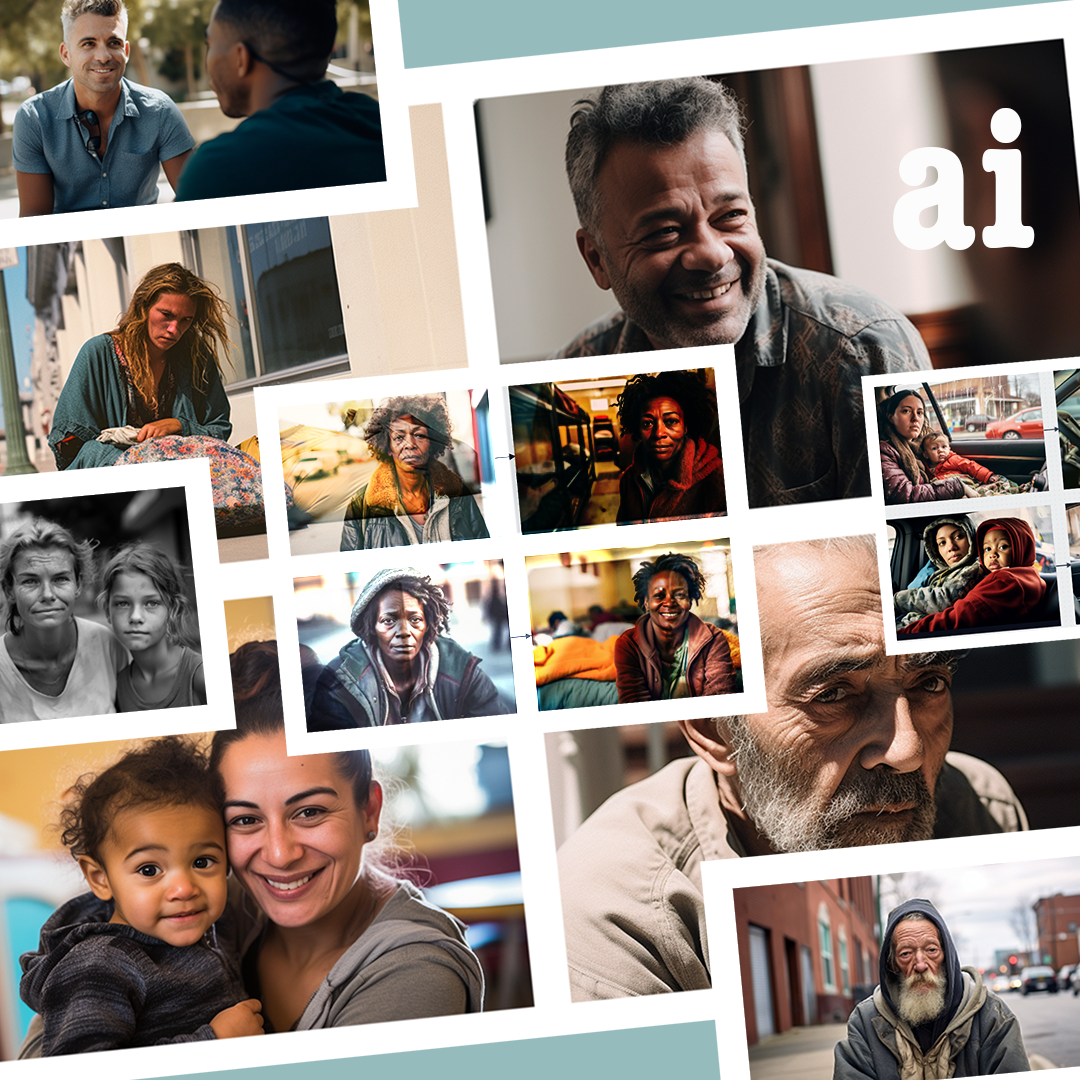Is it time for your organization to harness AI for greater efficiency & creativity?
In the world of data analytics, the last 30 years have been an ever-accelerating rollercoaster of transformation. The last decade in particular has been incredible… and the past year, nothing short of mind blowing.
The rapid revolutions in the world of AI content creation and data analytics have left many nonprofit organizations wondering how and if they should seek out ways to apply AI in their fundraising and marketing.
I’ve had the privilege of riding this wave, armed with a Master’s in Business Analytics, with a concentration in AI from NYU. But far from the halls of theory and education, you and I – and the entire world – have watched the quantum leaps in the world of AI happen right in front of us.
The AI landscape has been electrified by affordable cloud storage, computing power that dwarfs your parents’ computer, and significant private investments, including the pioneering work of OpenAI over this last year. It’s akin to the revolutions of the ‘80s PC, the ‘90s internet explosion and the 2000s cell phone craze, all bundled into one.
Let’s rewind for a moment: AI’s early days were marked by humdrum tasks like predicting future outcomes and crunching numbers. But fast forward to today, and AI isn’t just analyzing data… it’s analyzing cat videos, crafting Shakespearean sonnets and generating content that seemed like a fantasy a few years ago.
But why should nonprofit leaders like us care about AI? Why should we embrace this brave new world of technology? Let’s delve into the profound reasons why AI is essential for our industry.
AI Experiments in Nonprofit Fundraising & Marketing
At BDI, our Creative Team has formed an AI workgroup that’s been testing and investigating these new offerings. You might expect a creative team to worry about their careers in the face of this content-generating tech – but quite the opposite! Our team’s curiosity has led them to discover some remarkable benefits AI might bring for our fundraising and marketing work on behalf of our client partners.
Our Creative Team began experimenting with the new generative AI tools in the market and discovered that we could:
- Create life-like images of humans to protect the privacy of minors, victims of abuse and other sensitive subject matter in our fundraising campaigns.
- Create higher quality storyboards in a fraction of the time to design sets for upcoming photo and video shoots.
- Conduct linguistic analyses on fundraising copy to see which word choices and phraseology differentiated successful campaigns from unsuccessful ones.
Exciting? Absolutely! As someone with nearly four decades of experience, this is by far the most exhilarating time in my journey. We’re not merely witnessing a sci-fi revolution on screen; we’re actively shaping it. This AI revolution is transforming the nonprofit sector into a hub of even greater creativity and efficiency.
For nonprofits, understanding AI’s potential and applications has become paramount. Just like any technological innovation, AI possesses the power for both noble and nefarious purposes. Given the breathtaking speed at which AI is reshaping our personal and professional lives, adopting a “wait and see” approach is no longer viable. Those who step up to lead and embrace early AI adoption stand to capture not just a larger market share but also the hearts and minds of individuals who appreciate the transformative power of innovation.
AI Capabilities in Nonprofit Fundraising & Marketing
Since my graduation from NYU’s program, it’s astonishing to see how AI technology has evolved. Back then, AI primarily focused on complex pattern recognition, like identifying objects in images or predicting equipment failures. While these developments boosted business productivity, they were limited by slow computing power and fragmented data storage that prevented real-time content generation.
Today, large language models (LLMs), such as ChatGPT or Google Bard, boasting over 175 billion features have shattered these limitations, enabling the generation of highly relevant artifacts, such as written content, images and audio. This remarkable feat was unimaginable just 15 years ago. And the next horizon envisions AI-driven assistants operating across diverse knowledge domains, promising to elevate productivity and boost global GDP to even greater heights.
It may sound futuristic, but you may not realize: you’re already using AI daily. I’ve often said that if we could flip the AI switch OFF for just one week, within 5 minutes, 90% of us would be complaining how much more difficult and inconvenient (and perhaps dangerous) life has become. No GPS. No Amazon as we know it today. No streaming services. No social media. No Siri or Alexa. The anti-collision systems in cars wouldn’t work, nor would the banking apps on our phones. And that’s just the tip of the iceberg!
For nonprofits, AI is far from being a trend; it is truly a game-changer. With the majority of nonprofits operating on limited budgets and lean teams, the ability of AI to assist and support can potentially give these organization’s leaders back their time to do the work they’re uniquely talented and called to do: build relationships, connect with donors and serve their community’s greatest needs.
Experimenting with AI has never been easier, thanks to user-friendly platforms and a “pay to play” pricing model, eliminating the need for massive capital investments. Instead, any nonprofit can access these tools through modest monthly fees. These AI platforms are designed to be user-friendly, removing the requirement for technical expertise to operate them. This empowers nonprofit teams to experiment with intuitive, cost-effective and expeditious tools that hold immense potential.
That’s why I wholeheartedly encourage every nonprofit leader to challenge their teams to identify at least one AI productivity tool each quarter, engage in limited beta tests and report their findings to management. This proactive approach allows management to strategically allocate resources, ensuring the organization reaps the greatest returns from AI adoption across the board.
In this rapidly evolving AI landscape, the opportunity is yours for the taking – and the time to seize it is now.
AI Insights for Nonprofits: 3 Essential Articles from BDI
As we eagerly anticipate 2024, this remains abundantly clear: AI isn’t going anywhere, and neither is BDI’s commitment to harnessing its potential for the benefit of our client partners. As the Chief Intelligence Officer, I’m proud to affirm our unwavering dedication to continual learning and our unquenchable thirst for exploring new AI applications. We understand that each discovery has the potential to redefine the way BDI serves our partners – and increase our combined impact in the lives of even more people in need.
In the spirit of embracing AI, I’m excited to recommend three enlightening articles authored by my esteemed colleagues at BDI:
- Practical guidance on integrating AI into your nonprofit organization: James Read, Senior VP of Creative, delves deep into the intricate landscape of AI integration, offering indispensable insights at a time when navigating the multitude of AI tools can feel daunting. Read James’ article here>>
- Experimentation with advanced image generation through AI platforms: Jhovany Quiroz, Creative Producer and Storytellers Manager, tests the extraordinary capabilities of AI image generation and how it can bridge conventional gaps in photography for fundraising campaigns. Read Jhovany’s article here>>
- A beginner’s guide to using ChatGPT at your nonprofit: Justine Morales, Digital Technology Specialist, offers suggestions for getting started on ChatGPT and a few ways it might help lighten the load at your nonprofit. Read Justine’s article here>>
I hope you’ll dedicate some time and thoughtful consideration to these articles. They offer invaluable insights into the boundless potential of AI and its applications within the nonprofit sector. But this is just the beginning of our journey into AI and emerging technologies. I eagerly anticipate engaging in many more discussions with you on this transformative topic, as we navigate the ever-expanding landscape of innovation.
If you’re interested in learning more about how your organization can harness the power of AI to do more good in your community, please reach out. Together, we’ll shape a future where AI enhances our collective mission in the nonprofit sector. The path ahead is illuminated with endless possibilities, and I’m thrilled to walk it with you.
Stay updated on what’s next for nonprofit fundraising!
Sign up for our newsletter today to get the fuel that will help boost your fundraising for nonprofits to the next level.




